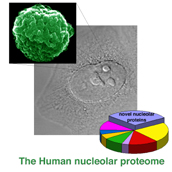

Gene Function Breakthrough

A breakthrough in understanding the functions of human genes has been reported by scientists working at the Wellcome Trust Biocentre.
The recent DNA sequencing of the human genome described the genes all humans carry in their cells, but it did not reveal the functions of most of these genes nor identify where in the cell they act.
A major collaborative project by Professor Angus Lamond and coworkers and Professor Matthias Mann and coworkers at Odense University in Denmark has now identified over 270 human proteins, including 80 novel proteins that are made by human genes and assembled into a specific cellular body called the "nucleolus". Despite nearly 20 years of previous research, scientists did not before know the full list of proteins in the nucleolus, a key part of the cell needed for growth and the production of new proteins.
Professor Lamond says: "This work is exciting because it gives us important new clues about how the nucleolus works and it will help scientists to determine what has gone wrong in many cancers and other diseases. The new proteins we have found have already led us to discover an entirely new type of cell structure called "paraspeckles". Some of the new proteins may also offer useful targets for future drug development."
Professor Mann said: "This work is a major technical achievement and is the largest study of this kind to be accomplished so far." Two manuscripts were published in the January issue of the international science journal, Current Biology.
Professor Lamond is the head of the division of gene regulation and expression in the school of life sciences. Professor Lamond came to the University in 1995 from the European Molecular Biology Laboratory in Heidelberg.
Caption - the human cell with a "pull out" of the nucleolar proteome and pie chart showing the proportion of novel proteins identified within it.
Next Page
Return to April 2002 Contact